 The climate there was always changed from what the rest of America knew. 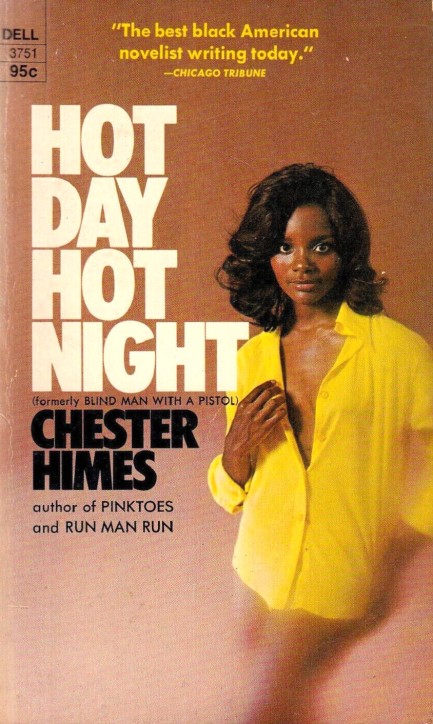
Legendary author Chester Himes originally published Hot Day Hot Night in 1969 as Blind Man with a Pistol, with this Dell photocover edition featuring a beautiful model coming in 1970. Those two years are about as far forward as we're willing to go when it comes to fiction for our website (we often read newer books, but don't write about them). Elmore Leonard and Stanley Ellin likewise have pushed the upper boundary of our vintage perimeter, so Himes, of course, has received an exception too.
Hot Day Hot Night features a typically digressive Himes narrative that derives from the murder of a charlatan and a missing suitcase of cash. The dead scam artist, who called himself Doctor Mubuta, had convinced a ninety-something preacher named Mister Sam that an arcane formula could restore youth and virility. It sounds a bit crazy that anyone would believe that, but Himes puts it succinctly: It wasn't any harder to believe in rejuvenation than to believe equality was coming. It's also easier to believe when you have no idea what the ingredients in the concoction are, as revealed in this amusing exchange:
“What's that milky stuff floating around in it?”
“That's albumin, same stuff as is the base for semen.”
“What's semen?”
Mubuta doesn't answer that—smartly, we think. Other elements of the miracle mixture include baboon balls, bits of rabbit, eagle, and shellfish, some rooster feathers, and a “concupiscent eye.” Of course, this is total baloney, though we never find out what's really in the stew. Ingredients readily available around Harlem exclude eagles. Anyway, when the deal goes awry and Mubuta ends up stabbed to death, Himes' franchise detective duo Grave Digger Jones and Coffin Ed Johnson are drawn into the investigation in what is their final official appearance here in the eighth novel in Himes' Harlem Detective cycle (they also featured in 1993's posthumously published Plan B).
We've described Himes as a sort of literary walk on the wild side, and he's as uncompromising as ever all these entries into his Harlem series. It will be interesting to see how his work is regarded as the years pass. Himes is a mirror image of writers like Chandler and Spillane, working along identical literary lines, casting nearly every character in his books as criminals or victims. But the expectations on Himes were different, because—indisputably—rules change according to who's playing the game, and what color they are. We recommend this book, and everything by Himes.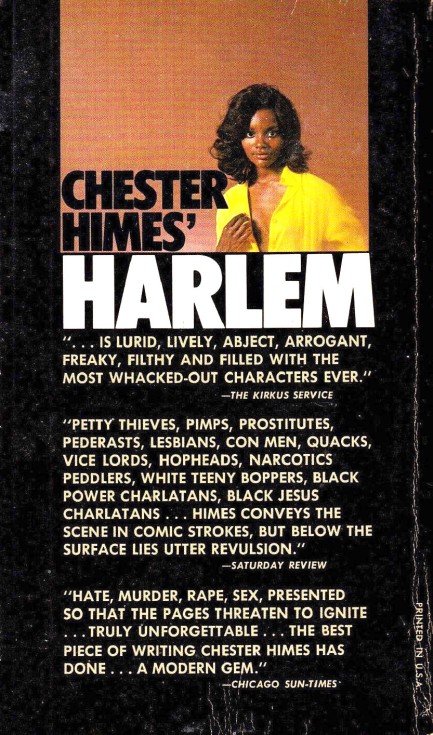
 As detective capers go, this one is a real Honey. 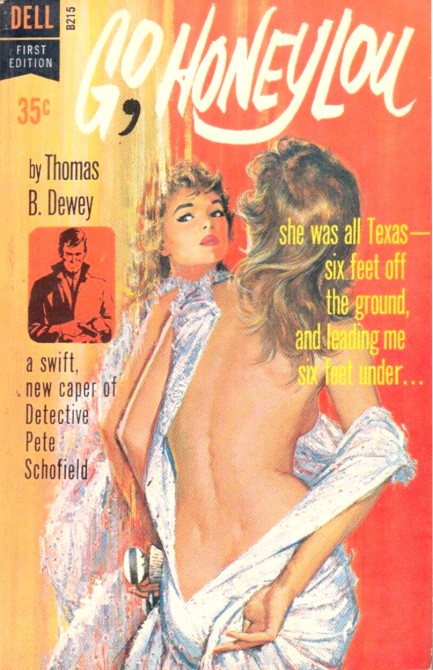
Victor Kalin painted this beautiful cover for Thomas B. Dewey's Go, Honeylou, published by Dell in 1962. The blurb describes the book as a “swift new caper,” and that's true. Private eye Pete Schofield is hired to drive a beautiful 6-foot bumpkin named Honeylou from L.A. to San Francisco. It's a strange request, considering a detective's high rate of pay, which is probably why Schofield doesn't seem surprised when he's immediately tailed, soon harassed, eventually beaten, and finally robbed of his human cargo. He next finds that all along he was delivering Honeylou to a whorehouse, that her guardian aunt has been murdered, and a massive cache of her money is in the wind. It all worked fine for us, however Go, Honeylou was written well into a Pete Schofield series, and we'd have preferred to start with book one. But whaddaya gonna do? We've since noticed a couple of earlier entries out there at good prices. Since this one was good, we might buy those and report back.

 The cover art for Murder in the Wind changes like the weather. 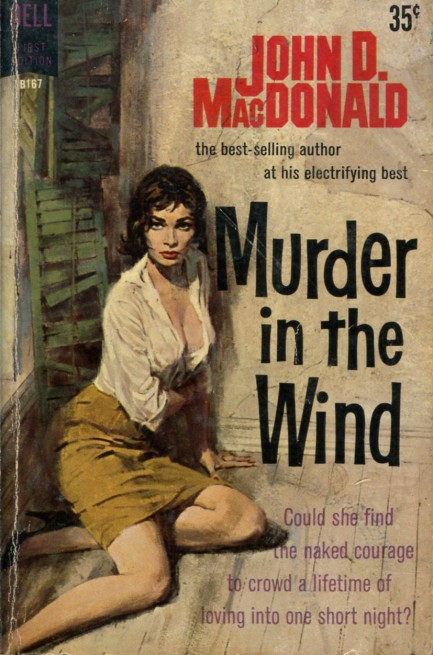 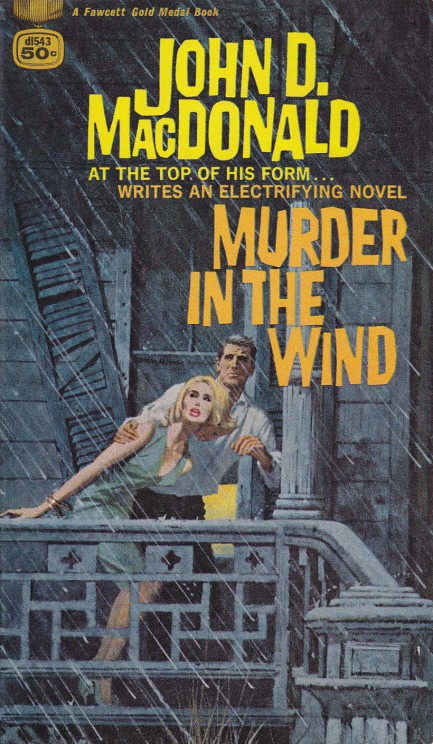
The copy we read of John D. MacDonald's natural disaster thriller Murder in the Wind a while back had a front painted by George Gross. The two covers you see above were painted by Bob Abbett and Robert McGinnis. Their art goes in different directions. Abbett's shows nothing related to bad weather but uses a dilapidated background to imply that his cover figure is stranded, while McGinnis went for an outdoor setting cut by slanting rain, also using a dilapidated house motif. Both efforts are excellent, and the book is good too, as we mentioned here.
 She was bound to have trouble. 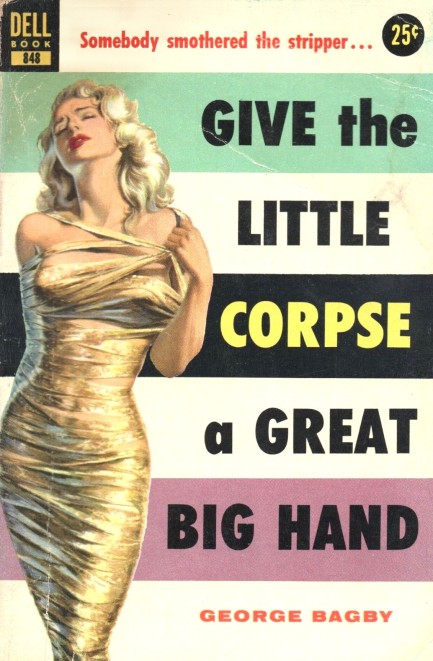
1953's Give the Little Corpse a Great Big Hand by George Bagby, aka Aaron Marc Stein, is a murder tale in classic whodunnit style about a burlesque performer named Goldie Gibbs who's debuting a routine at the famed but fictive Limehouse Club in which she's wrapped like a mummy and carried onstage in a golden coffin from which she rises and strips. Unfortunately, Goldie never rises because she's been murdered. On the case is New York City homicide inspector No-First-Name Schmidt.
Schmidt had been a franchise character for Babgy since 1936 and would eventually star in fifty-plus novels, the last in 1983. Here he cycles through various suspects with incisive questioning, and soon finds links between the murder, the local organized crime kingpin, and a spate of jewel robberies that happened the same night, while also learning that a colleague's daughter who sings at the Limehouse Club has some connection to the crime—unwittingly, beyond a doubt, because she's a “sweet kid.”
This and the other Schmidt books are narrated not by the inspector, but by a journalist named George Bagby—yes, same as the author—who publishes the tales in a magazine. From first person point-of-view Bagby gives readers the procedural details of the case, while also admiring his friend's great intelligence. Give the Little Corpse a Great Big Hand is mostly interrogations and speculations. While we've grown to prefer authors who build books a bit more around action, Bagby/Stein's all-brains approach works fine, and for whodunnit fans we'd call this a necessary read.
Moving on to the cover, it was painted by Victor Kalin and it's a nice effort, capturing the doomed Gibbs' shimmery gold mummy wrapping as described in the text, but taking a non-literal approach otherwise. We guess painting a dead woman in a coffin wasn't considered enticing, so Kalin came up with this moment that doesn't occur in the story but mirrors her distress. He made the right decision, and the result is eye-catching, as usual with his work. Check here, here, and here for examples.
 Africa gets extra hot in Garnier jungle drama. 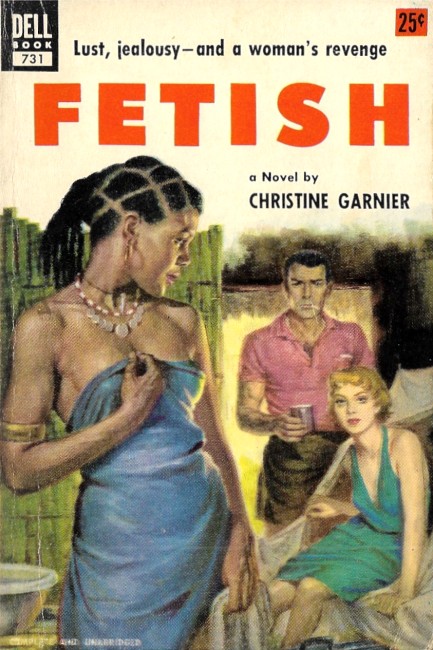
Once again we've been drawn to literature set in Africa, this time in the form of Christine Garnier's romantic drama Fetish, originally published in 1951 in French as Va-t'en avec les tiens! Our edition is from 1953, published by Dell, translated into English, and bearing excellent cover art by Griffith Foxley. The rear cover is interesting as well, particularly because Dell toplined a middling review from Time magazine after molding it into glowing praise: As stirring and authentic as a native dance... throughly convincing... effective... flashing. What the review actually said, in part, was: Garnier [combined] her minor talent for fiction with her knowledge of African life. The result was Fetish, a novel which sold a phenomenal (for France) 135,000 copies. Garnier still lacks skill as a novelist, but in Fetish it scarcely seems to matter. The book's main virtue is its French West African background, as stirring and authentic as a native dance.
Okay, Time magazine can take a flying leap. Garnier can write just fine. Fetish is about a Westernized African woman named Doéllé who works in the Manoho district of Togoland as a nurse for a French doctor. She has a white lover named Flavien who's a local magistrate. When the doctor's hot wife Urguèle arrives from Paris, every white man in the district—including Flavien—desires her. Doéllé is likewise thought by all to be quite a dish. But she isn't white. Urguèle's easy assertion of privilege, and her husband's eventual realization that she wishes to stray, sets up a dangerous love rectangle that propels Doéllé toward—let's say—locally traditional solutions for the problem, despite her education and Westernization.
Fetish avoids some pitfalls of mid-century novels written by whites about Africa. Actually, “avoid” makes it sound conscious. Garnier is simply a sensitive writer, and because the story is narrated by Doéllé, it lacks some of the usual arrogance toward its setting. Time noted that authenticity is a strength of the book, and that's correct. One aspect of this authenticity that goes against the grain of every book we've ever read set in Africa is that, according to Garnier, it was impossible for whites to have a secret affair. Africans were so fascinated and mystified by these pale aliens, as well as wary of them, that they never left them unobserved, and shared everything seen and overheard. Even barred from places, they still noted all who came and went where they themselves weren't allowed. That extreme lack of privacy rings true to us, due to our many experiences as foreigners in tropical hamlets.
As we said, Doéllé narrates Fetish, and because she's acquainted with so many native children and servants in Manoho, she's the beneficiary of all their observations, eavesdropping, and gossip, as described above. The book's point of view shifts between first person, to third person filtered through the many eyes and ears of the district, and even farther, as Doéllé extrapolates Urguèle's, Flavien's, and others' innermost thoughts and musings. In practice she's a first-person, limited-third-person, and unlimited-omniscient narrator. We thought that was a nice trick by Garnier. So Fetish has authenticity, atmosphere, star-crossed lovers, and a good story, all well woven. Time can get bent. Was the book pulp? Not really, but there's passion and danger, and we found it enjoyable.
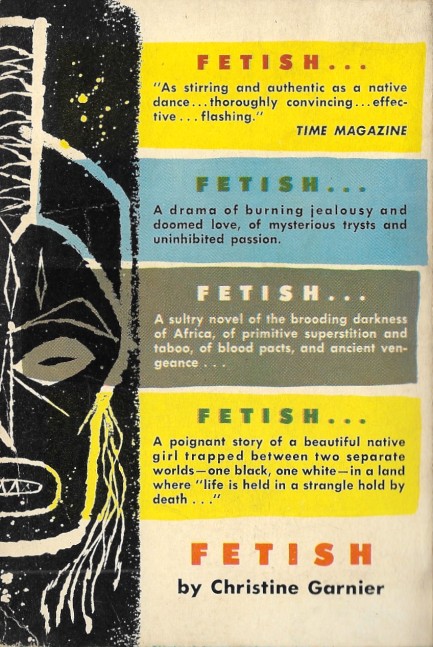
 If nobody answers you're about to find a body. 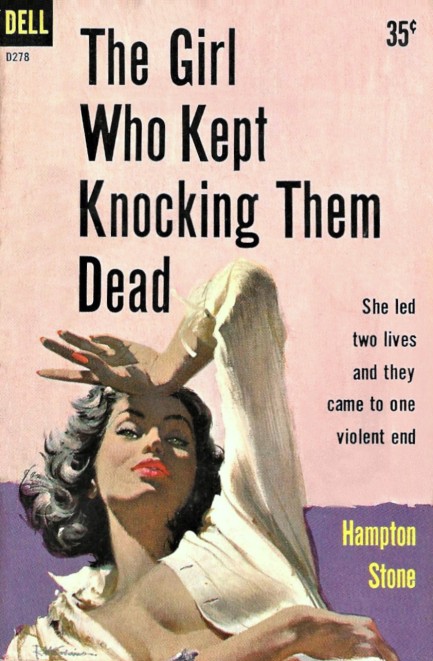
Above is Robert McGinnis cover art for Hampton Stone's 1957 novel The Girl Who Kept Knocking Them Dead, which is basically a crime procedural, told from first person perspective by an assistant D.A., but focused on the narrator's capable partner Jeremiah Gibson. The saga begins with the strangulation murder of a New York City woman who had been leading a double life. That murder leads to others, as the mysterious killer tries to cover his or her tracks. The title of the book is a potential misdirection play. You expect the killer to be one of the female characters, but there are men who might be guilty as well. Overall, the tale isn't compelling, but that isn't an issue with writing skill, so much as voice. It's too limited. Stone's narrator isn't interesting. His genius investigator Gibson is, but with everything filtered through the admiring partner's recollections the tale never takes flight as it might have. We probably won't try Stone again, but he wrote a lot of books, so you never know.
 Mwah! I love you left hook. You get it done every time. 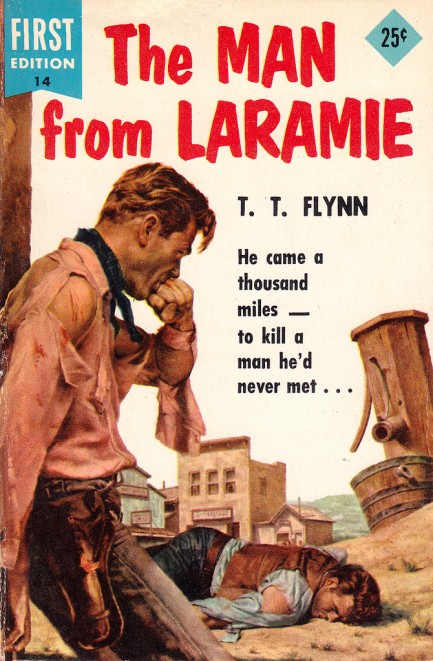
1954's The Man from Laramie by T.T. Flynn is fronted by Stanley Borack art featuring a standing figure nursing sore knuckles, but we prefer to think of him as gratefully kissing his fist. You get a couple of archetypal western elements in this novel, most importantly the mysterious stranger from out of town, and the powerful rancher with no scruples. If the title sounds familiar, it's probably because the book was made into a hit 1955 movie with James Stewart. We may have a look at that later.
 Some actresses consider it a role to die for—literally. 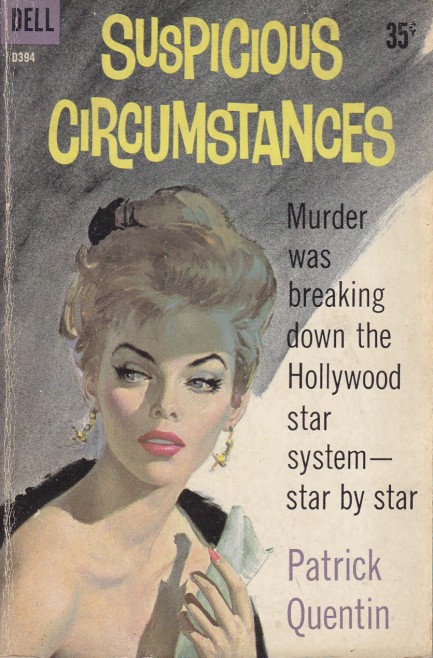
This is a beautiful Robert Maguire cover, somewhat different from his normal style, that he painted for Patrick Quentin's 1957 mystery Suspicious Circumstances. Quentin was a pseudonym used by various authors, but in this case Hugh Wheeler was behind the façade. The cover blurb describes murder breaking down the Hollywood star system, and that's basically what you get, as the book centers around nineteen-year-old Nick Rood, nervous son of globally adored actress Anny Rood, and follows his suspicions that his mother has killed in order to steal a plum movie role. The book is written in amusing and affected fashion, and is filled with characters speaking in ways no humans do, or likely ever did:
“It's positively Greek. Sophocles would purr. Aeschylus would run not walk to the nearest papyrus or whatever he wrote on.”
How very arch. Thanks to various crises, third party manipulations, and suspicious deaths, the coveted film role repeatedly falls into and out of Anny Rood's lap, while fragile Nick flips and flops from suspecting his mother of murder to not. Meanwhile a newcomer to the entourage, a young secretary named Delight Schmidt, turns Nick's head with her beauty and sweetness, but may be just ambitious enough to have a hand in everything that's occurring. Mid-century authors seem addicted to portraying Hollywood in comical or farcical fashion, but we can't argue with the results here. Suspicious Circumstances is well written, generally interesting, and occasionally funny as hell.
 No man who dumps her ever lives to regret it. 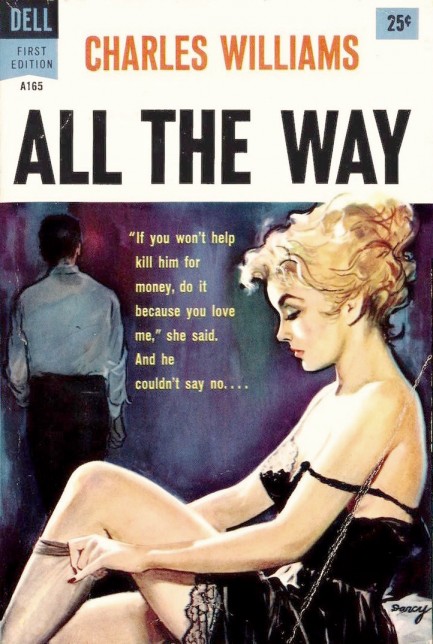
 One day there will be no more Charles Williams for us to read, and that'll be sad, but his books, like good wine, are something you have to treat yourself to regularly even as the stock dwindles. His 1958 novel All the Way, which is the source material for the 1960 movie The 3rd Voice, is typically solid Williams work. One day there will be no more Charles Williams for us to read, and that'll be sad, but his books, like good wine, are something you have to treat yourself to regularly even as the stock dwindles. His 1958 novel All the Way, which is the source material for the 1960 movie The 3rd Voice, is typically solid Williams work.
It has a fascinating plot at its center. A vengeful woman enlists a fugitive to help her steal her former lover's identity, then impersonate him for weeks afterward so nobody will suspect when he disappears that she's actually killed him. The reason people are supposed to assume a disappearance instead of murder has to do with paranoid schizophrenia in the ex-lover's family, and the fact that the fugitive impersonating him has been faking its rapid onset, publicly and loudly.
With the ground laid in this way, a disappearance will be the logical conclusion, and since the man is rich, the fact that a hundred seventy grand is missing from his bank accounts merely indicates he's never coming back—not that an imposter has withdrawn the cash. The scheme is convoluted, but the genius femmes who come up with them are a staple of pulp literature. Williams gets the job done again, as does Ernest Chiriacka, who painted the cover art.
 Fontaine returns for another deadly installment of the hunger dames. 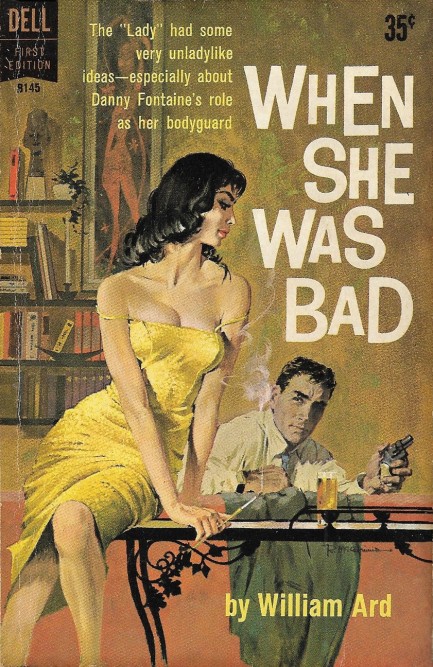
It's official. William Ard, in all his incarnations, is a trusted author. In 1960's When She Was Bad, the follow-up to 1959's As Bad As I Am, Danny Fontaine is now a fledgeling detective on his first case. Many mid-century detectives are ladykillers, but Fontaine is on a level that silences rooms when he enters. He's what women these days might amusingly call a “dilf”—a detective I'd like to fuck. His job is to locate a missing minor royal, a thrillseeker who's caused a ruckus from Grand Bahama to New York City but now may be in trouble way over her head. Fontaine mixes with women ranging from a marquess related by marriage to the Queen of England to a trio of top rank call girls, and they all fall hard for him. His efforts to earn his wings as a private operator under these circumstances are often funny and always exciting. Simply put, Ard's got skills. The cover art on this Dell edition is by Robert McGinnis, and he's got skills too.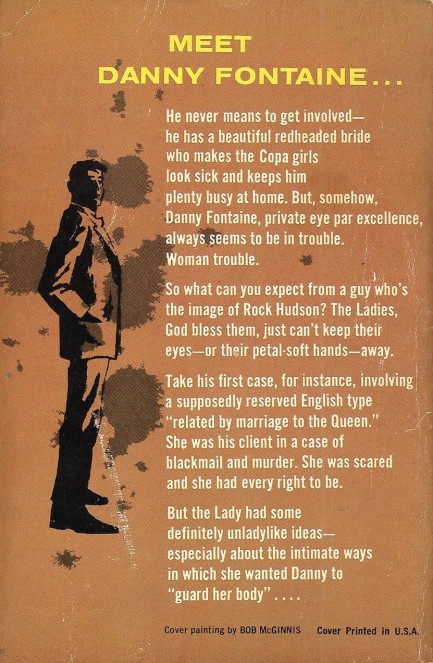
 |  |
|
 |

The headlines that mattered yesteryear.
1985—Theodore Sturgeon Dies
American science fiction and pulp writer Theodore Sturgeon, who pioneered a technique known as rhythmic prose, in which his text would drop into a standard poetic meter, dies from lung fibrosis, which may have been caused by his smoking, but also might have been caused by his exposure to asbestos during his years as a Merchant Marine. 1945—World War II Ends
At Reims, France, German General Alfred Jodl signs unconditional surrender terms, thus ending Germany's participation in World War II. Jodl is then arrested and transferred to the German POW camp Flensburg, and later he is made to stand before the International Military Tribunal at the Nuremberg Trials. At the conclusion of the trial, Jodl is sentenced to death and hanged as a war criminal. 1954—French Are Defeated at Dien Bien Phu
In Vietnam, the Battle of Dien Bien Phu, which had begun two months earlier, ends in a French defeat. The United States, as per the Mutual Defense Assistance Act, gave material aid to the French, but were only minimally involved in the actual battle. By 1961, however, American troops would begin arriving in droves, and within several years the U.S. would be fully embroiled in war. 1937—The Hindenburg Explodes
In the U.S, at Lakehurst, New Jersey, the German zeppelin LZ 129 Hindenburg catches fire and is incinerated within a minute while attempting to dock in windy conditions after a trans-Atlantic crossing. The disaster, which kills thirty-six people, becomes the subject of spectacular newsreel coverage, photographs, and most famously, Herbert Morrison's recorded radio eyewitness report from the landing field. But for all the witnesses and speculation, the actual cause of the fire remains unknown. |

|
|

It's easy. We have an uploader that makes it a snap. Use it to submit your art, text, header, and subhead. Your post can be funny, serious, or anything in between, as long as it's vintage pulp. You'll get a byline and experience the fleeting pride of free authorship. We'll edit your post for typos, but the rest is up to you. Click here to give us your best shot.

|
|











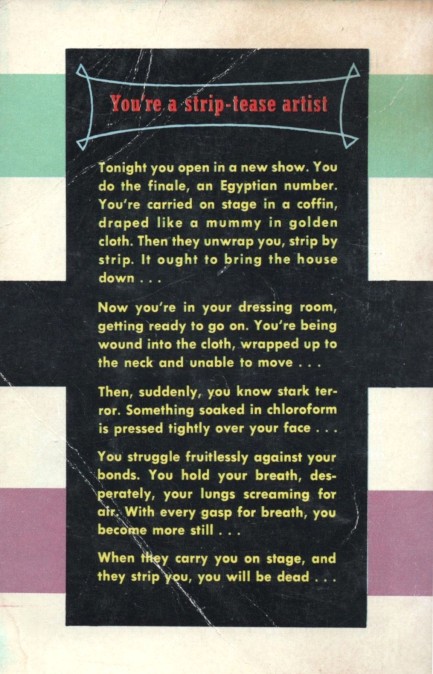











 One day there will be no more Charles Williams for us to read, and that'll be sad, but his books, like good wine, are something you have to treat yourself to regularly even as the stock dwindles. His 1958 novel All the Way, which is the source material for the 1960 movie The 3rd Voice, is typically solid Williams work.
One day there will be no more Charles Williams for us to read, and that'll be sad, but his books, like good wine, are something you have to treat yourself to regularly even as the stock dwindles. His 1958 novel All the Way, which is the source material for the 1960 movie The 3rd Voice, is typically solid Williams work.








































































